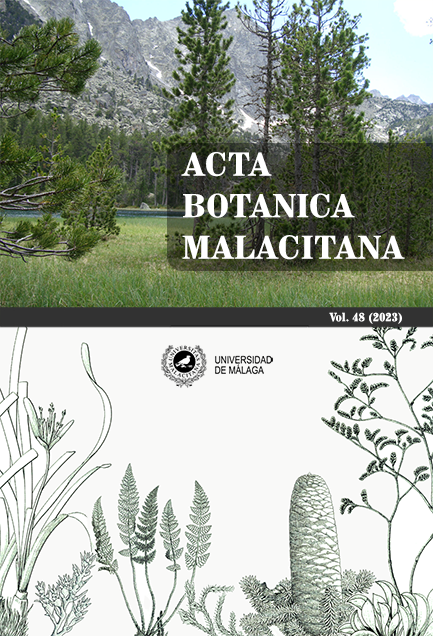On the type of Genista terniflora (Loteae-Leguminosae)
DOI:
https://doi.org/10.24310/abm.v48i.15333Keywords:
Anthyllis terniflora, Lagasga, nomenclatura, tipificación, España, Comunidad ValencianaAbstract
The name Genista terniflora (Anthyllis terniflora) is neotypified. A specimen
preserved in the herbarium of the Royal Botanical Garden of Madrid (at MA) and
collected by Cavanilles in 1792 is selected as the neotype.
Downloads
Metrics
References
Benedí, C. (1995). Taxonomía del grupo de Anthyllis henoniana Coss. (Leguminosae): A. lagascana, nom. nov. Anales del Jardín Botánico de Madrid, 53(2), 282–284.
Benedí, C. (1998). Consideraciones sobre el género Anthyllis L. (Loteae-Leguminosae) y su tratamiento en Flora iberica. Anales del Jardín Botánico de Madrid, 56(2), 279–303.
Benedí, C. (2000). Anthyllis L. In S. Talavera, S., Aedo, C., Castroviejo, S., Herrero, A., Romero Zarco, C., Salgueiro, F.J. & Velayos, M. (Eds), Flora iberica, 7(2), pp. 829–863. Madrid: Real Jardín Botánico, CSIC.
Bolòs, O. de & Vigo, J. (1984). Flora dels Països Catalans, vol. 1. Barcelona: Ed. Barcino. Candolle, A.P. (1825). Prodromus systematis naturalis regni vegetabilis, vol. 2. Paris: Treuttel & Wurtz.
Dufour, M.L. (1860) Diagnosis et observations critiques sur quelques plantes d’Espagne mal connues ou nouvelles (suite). Bulletin de la Société Botanique de France, 7, 426–433.
Ferrer-Gallego, P.P. & Guara, M. (2016). A new hybrid in the genus Anthyllis (Loteae-Leguminosae) from the Eastern Iberian Peninsula. Anales del Jardín Botánico de Madrid, 73(2), e040.
Guara, M. & Ferrer, P.P. (2006). Anthyllis ×fortuita, un nuevo híbrido natural en el género Anthyllis L. (Leguminosae). Acta Botanica Malacitana, 31, 171–172.
Lagasca y Segura, M. (1816) Genera et species plantarum, quae aut novae sunt aut nondum recte cognoscuntur. Madrid: Ex Typographia Regia.
Malagarriga, R. (1976). Sinopsis de la flora ibérica, vol. XL. Barcelona: Laboratorio Botánico Sennen, La Salle Bonanova.
Mateo, G. & Figuerola, R. (1987). Flora analítica de la provincia de Valencia. Valencia: IAM. Ediciones Alfons el Magnánim, Institució Valenciana d’Estudis i Investigació.
Pau, C. (1925). Contribución a la flora española. Plantas de Almería. Memorias del Museo de Ciencias Naturales de Barcelona, Serie Botánica, 1(3), 1–33.
Thiers, B. (2023 [continuously updated]). Index Herbariorum: A global directory of public herbaria and associated staff. New York Botanical Garden’s Virtual Herbarium. Available from: https://sweetgum.nybg.org/ih/ (accessed 14 January 2023)
Turland, N.J., Wiersema, J.H., Barrie, F.R., Greuter, W., Hawksworth, D.L., Herendeen, P.S., Knapp, S., Kusber, W.-H., Li, D.-Z., Marhold, K., May, T.W., McNeill, J., Monro, A.M., Prado, J., Price, M.J. & Smith, G.F. (Eds.) (2018). International Code of Nomenclature for algae, fungi, and plants (Shenzhen Code) adopted by the Nineteenth International Botanical Congress Shenzhen, China, July 2017. [ Regnum Vegetabile 159]. Glashu?tten: Koeltz Botanical Books. https://doi.org/10.12705/Code.2018
Downloads
Published
How to Cite
Issue
Section
License
Copyright (c) 2023 Acta Botanica Malacitana

This work is licensed under a Creative Commons Attribution-NonCommercial-ShareAlike 4.0 International License.
All information related to the licensing of published works in Acta Botanica Malacitana and copyright can be found in our Editorial Policy.







1.png)
